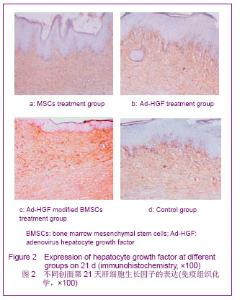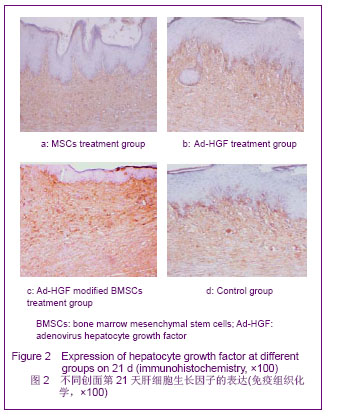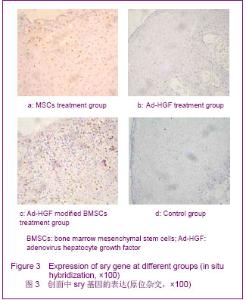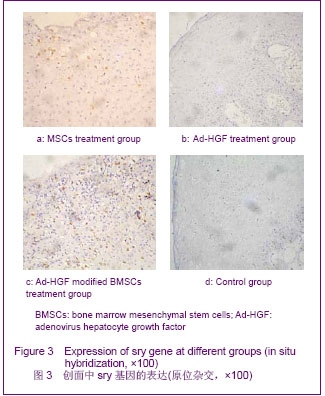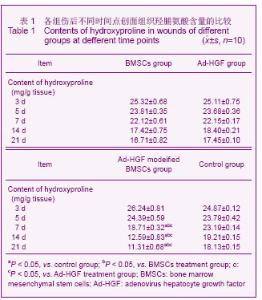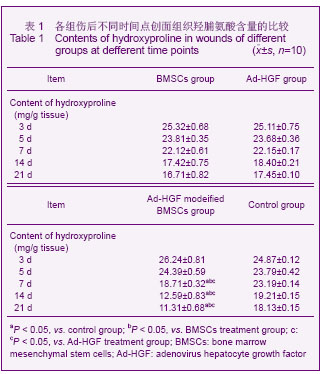Chinese Journal of Tissue Engineering Research ›› 2012, Vol. 16 ›› Issue (49): 9226-9231.doi: 10.3969/j.issn.2095-4344.2012.49.019
Previous Articles Next Articles
Effects of adenovirus hepatocyte growth factor modified bone marrow mesenchymal stem cells on radioactive skin wound healing
Ha Xiao-qin, Zhang Jun, Deng Zhi-yun, Dong Ju-zi, Peng Jun-hua, Zhao Yong, Zhang Yuan-yuan
- Department of Clinical Laboratory, Lanzhou Military General Hospital of Chinese PLA, Key Laboratory of Stem Cell and Gene Medicine of Gansu Province, Lanzhou 730050, Gansu Province, China
-
Received:2012-01-12Revised:2012-02-27Online:2012-12-02Published:2013-01-16 -
About author:Ha Xiao-qin☆, Doctor, Chief physician, Department of Clinical Laboratory, Lanzhou Military General Hospital of Chinese PLA, Key Laboratory of Stem Cell and Gene Medicine of Gansu Province, Lanzhou 730050, Gansu Province, China haxq@yahoo.com -
Supported by:“Eleventh Five-Year” Key Project of Chinese PLA (General Program), No. 06MB097*; Scientific Research Projects of Lanzhou Military Region, No. CLZ11J09*; the “Twelfth Five-Year” Key Project of Chinese PLA (General Program), No. CWS11C229*
CLC Number:
Cite this article
Ha Xiao-qin, Zhang Jun, Deng Zhi-yun, Dong Ju-zi, Peng Jun-hua, Zhao Yong, Zhang Yuan-yuan. Effects of adenovirus hepatocyte growth factor modified bone marrow mesenchymal stem cells on radioactive skin wound healing[J]. Chinese Journal of Tissue Engineering Research, 2012, 16(49): 9226-9231.
share this article
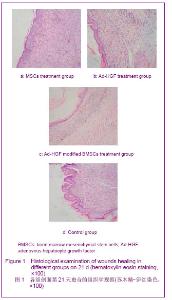
2.1 Ad-HGF可有效转染间充质干细胞 经Percoll密度梯度分离得到的骨髓单个核细胞接种于培养瓶中, 24 h后弃去未贴壁细胞,更换新鲜培养液。继续培养 72 h时出现纺锤状贴壁细胞,在培养10 d左右时细胞呈克隆样生长,12 d左右达30%细胞,并传代培养,记为P1代。间充质干细胞呈典型的纤维状细胞结构,形态较为均一。Ad-HGF转染间充质干细胞后24 h,ELISA检测到上清中肝细胞生长因子水平为(83.7±0.21) μg/L ×106细胞,表明Ad-HGF成功转染修饰了间充质干细胞。 2.2 组织学观察与免疫组织化学染色 伤后第7天,4组动物所有创面均形成较硬的痂皮。伤后14 d创缘有新生肉芽组织生成,21 d大部分创面愈合。第21天苏木 精-伊红染色显示,Ad-HGF修饰的间充质干细胞治疗组再生表皮明显薄于溶剂对照组,并可见丰富的新生小血管,Ad-HGF修饰的间充质干细胞治疗组与间充质干细胞治疗组和Ad-HGF治疗组比较,表皮更平整,新生小血管更丰富,见图1。 "
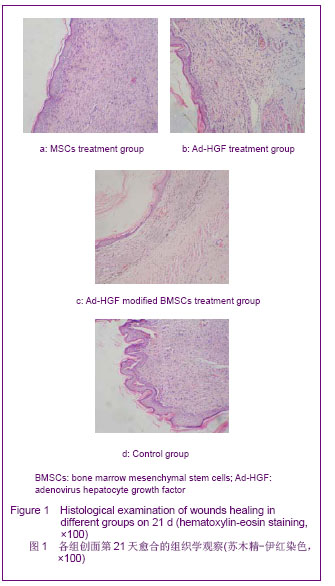
| [1] Fu XB.Zhongguo Gongchen Kexue.2009;11(10):122-128.付小兵. 组织再生:梦想、希望和挑战[J]. 中国工程科学,2009; 11(10):122-128.[2] Shen J,Tsai YT,Dimarco NM,et al.Transplantation of mesenchymal stem cells from young donors delays aging in mice.Sci Rep.2011;1:67.[3] Mariani E,Facchini A.Clinical Applications and biosafety of human adult mesenchymal stem cells.Curr Pharm Des. 2012;1:19.[4] Mazo M,Arana M,Pelacho B,et al. Mesenchymal stem cells and cardiovascular disease: a bench to bedside roadmap. Stem Cells Int. 2012;2012:175979[5] Bernardo ME, Locatelli F, Fibbe WE, et al. Mesenchymal stromal cells.Ann N Y Acad Sci.2009;1176(9):101-117.[6] Dou YR,Fu XB.Zhongguo Weizhongbing Jijiu Yixue. 2004; 16(8):499-501.都义日,付小兵.骨髓间充质干细胞的研究进展[J].中国危重病急救医学,2004,16(8):499-501.[7] Cao Q,Wang F,Lin J,et al. Mesenchymal stem cells enhance the differentiation of c-kit+ cardiac stem cells. Front Biosc. 2012;17:1323-1328.[8] Undale AH, Westendorf JJ, Yaszemski MJ, et al. Mesenchymal stem cells for bone repair and metabolic bone diseases.Mayo Clin Proc.2009;84(10):893-902.[9] Ha XQ, Yuan B,Li YM,et al.Gene Therapy for pathological scar with hepatocyte growth factor mediated by recombinant adenovirus vector.Science in China.2003;46(3):320-327.[10] Ha XQ, Dong F,Lv TD.Zhongguo Xiufu Chongjian Waike Zazhi. 2010;24(5):613-617.哈小琴,董芳,吕同德.肝细胞生长因子基因对BMSCs的修饰及活性观察[J].中国修复重建外科杂志,2010;24(5):613-617.[11] Jin LJ,Ha XQ,Zhang C,et al.Xibei Guofang Yixue Zazhi. 2007; 28(1):12-15.金丽娟,哈小琴,张诚,等.Ad-HGF修饰MSCs异体移植对烧伤创面愈合的作用[J].西北国防医学杂志,2007;28(1):12-15[12] Woessner J. The determination of hydroxyproline in tissue and protein sample contain small proportion of this amino acid. Arch Biochem Biophys.1961;93:440.[13] Sadiq AA,Geynisman DM,Salgia R. Inhibition of MET receptor tyrosine kinase and its ligand hepatocyte growth factor.J Thorac Oncol. 2011;6(11 Suppl 4):S1810-1.[14] Nakamura T,Sakai K,Nakamura T,et al. Hepatocyte growth factor twenty years on: Much more than a growth factor.J Gastroenterol Hepatol. 2011;1:188-202.[15] Lei X,Wu J,Liu B,et al. Hepatocyte growth factor promoting the proliferation of human eccrine sweat gland epithelial cells is relative to AKT signal channel and β-catenin.Arch Dermatol Res.2012;304(1):23-29.[16] Ananth KV,Asad M,Prem Kumar N,et al. Evaluation of wound healing potential of bauhinia purpurea leaf extracts in rats r.Indian J Pharm Sci.2010 ;72(1):122-127.[17] Sanwal R,Chaudhary AK. Wound healing and antimicrobial potential of Carissa spinarum Linn. in albino mice.J Ethnopharmacol.2011;135(3):792-796.[18] Krause DS, Theise ND, Collector MI, et al. Multi-organ, multi-lineage engraftment by a single bone marrow-derived stem cell.Cell.2001;105:369-377.[19] Korbing M, Katz RL, Khanna A, et al. Hepatocytes and epithelial cells of donor origin in recipients of peripheral-blood stem cells.N Engl J Med.2002;346:738-746.[20] Williams AR,Hare JM.Mesenchymal stem cells: biology, pathophysiology, translational findings, and therapeutic implications for cardiac disease.Cir Res. 2011;109(8): 923-940. |
| [1] | Lyu Ruyue, Gu Lulu, Liu Qian, Zhou Siyi, Li Beibei, Xue Letian, Sun Peng. Regulatory mechanisms of exosome secretion and its application prospects in biomedicine [J]. Chinese Journal of Tissue Engineering Research, 2026, 30(1): 184-193. |
| [2] | Xu Canli, He Wenxing, Wang Yuping, Ba Yinying, Chi Li, Wang Wenjuan, Wang Jiajia. Research context and trend of TBK1 in autoimmunity, signaling pathways, gene expression, tumor prevention and treatment [J]. Chinese Journal of Tissue Engineering Research, 2026, 30(在线): 1-11. |
| [3] | Liu Xun, Ouyang Hougan, Pan Rongbin, Wang Zi, Yang Fen, Tian Jiaxuan . Optimal parameters for physical interventions in bone marrow mesenchymal stem cell differentiation [J]. Chinese Journal of Tissue Engineering Research, 2025, 29(31): 6727-6732. |
| [4] | Hu Enxi, He Wenying, Tao Xiang, Du Peijing, Wang Libin. Regulation of THZ1, an inhibitor of cyclin-dependent kinase 7, on stemness of glioma stem cells and its mechanism [J]. Chinese Journal of Tissue Engineering Research, 2025, 29(25): 5374-5381. |
| [5] | Lin Meiyu, Zhao Xilong, Gao Jing, Zhao Jing, Ruan Guangping. Action mechanism and progress of stem cells against ovarian granulosa cell senescence [J]. Chinese Journal of Tissue Engineering Research, 2025, 29(25): 5414-5421. |
| [6] | Tian Zhenli, Zhang Xiaoxu, Fang Xingyan, Xie Tingting. Effects of sodium arsenite on lipid metabolism in human hepatocytes and regulatory factors [J]. Chinese Journal of Tissue Engineering Research, 2025, 29(23): 4956-4964. |
| [7] | Han Fang, Shu Qing, Jia Shaohui, Tian Jun. Electrotactic migration and mechanisms of stem cells [J]. Chinese Journal of Tissue Engineering Research, 2025, 29(23): 4984-4992. |
| [8] | Hu Chen, Jiang Ying, Chen Jia, Qiao Guangwei, Dong Wen, Ma Jian. Preparation and characterization of alendronate/chitosan/polyvinyl alcohol composite hydrogel films [J]. Chinese Journal of Tissue Engineering Research, 2025, 29(22): 4720-4730. |
| [9] | Yang Chao, Luo Zongping. Small molecule drug TD-198946 enhances osteogenic differentiation of rat bone marrow mesenchymal stem cells [J]. Chinese Journal of Tissue Engineering Research, 2025, 29(13): 2648-2654. |
| [10] | Li Xiaofeng, Zhao Duo, Ouyang Qin, Pang Zixiang, Li Yuquan, Chen Qianfen. Protective effect of mangiferin on oxidative stress injury in rat bone marrow mesenchymal stem cells [J]. Chinese Journal of Tissue Engineering Research, 2025, 29(13): 2669-2674. |
| [11] | Hu Zezun, Yang Fanlei, Xu Hao, Luo Zongping. Effect of surface roughness of polydimethylsiloxane on osteogenic differentiation of bone marrow mesenchymal stem cells under stretching conditions [J]. Chinese Journal of Tissue Engineering Research, 2025, 29(10): 1981-1989. |
| [12] | Yang Zhihang, Sun Zuyan, Huang Wenliang, Wan Yu, Chen Shida, Deng Jiang. Nerve growth factor promotes chondrogenic differentiation and inhibits hypertrophic differentiation of rabbit bone marrow mesenchymal stem cells [J]. Chinese Journal of Tissue Engineering Research, 2025, 29(7): 1336-1342. |
| [13] | Huang Ting, Zheng Xiaohan, Zhong Yuanji, Wei Yanzhao, Wei Xufang, Cao Xudong, Feng Xiaoli, Zhao Zhenqiang. Effects of macrophage migration inhibitory factor on survival, proliferation, and differentiation of human embryonic stem cells [J]. Chinese Journal of Tissue Engineering Research, 2025, 29(7): 1380-1387. |
| [14] | Liu Haowen, Qiao Weiping, Meng Zhicheng, Li Kaijie, Han Xuan, Shi Pengbo. Regulation of osteogenic effects by bone morphogenetic protein/Wnt signaling pathway: revealing molecular mechanisms of bone formation and remodeling [J]. Chinese Journal of Tissue Engineering Research, 2025, 29(3): 563-571. |
| [15] | Zhou Shijie, Li Muzhe, Yun Li, Zhang Tianchi, Niu Yuanyuan, Zhu Yihua, Zhou Qinfeng, Guo Yang, Ma Yong, Wang Lining. Effect of Wenshen Tongluo Zhitong formula on mouse H-type bone microvascular endothelial cell/bone marrow mesenchymal stem cell co-culture system [J]. Chinese Journal of Tissue Engineering Research, 2025, 29(1): 8-15. |
| Viewed | ||||||
|
Full text |
|
|||||
|
Abstract |
|
|||||
